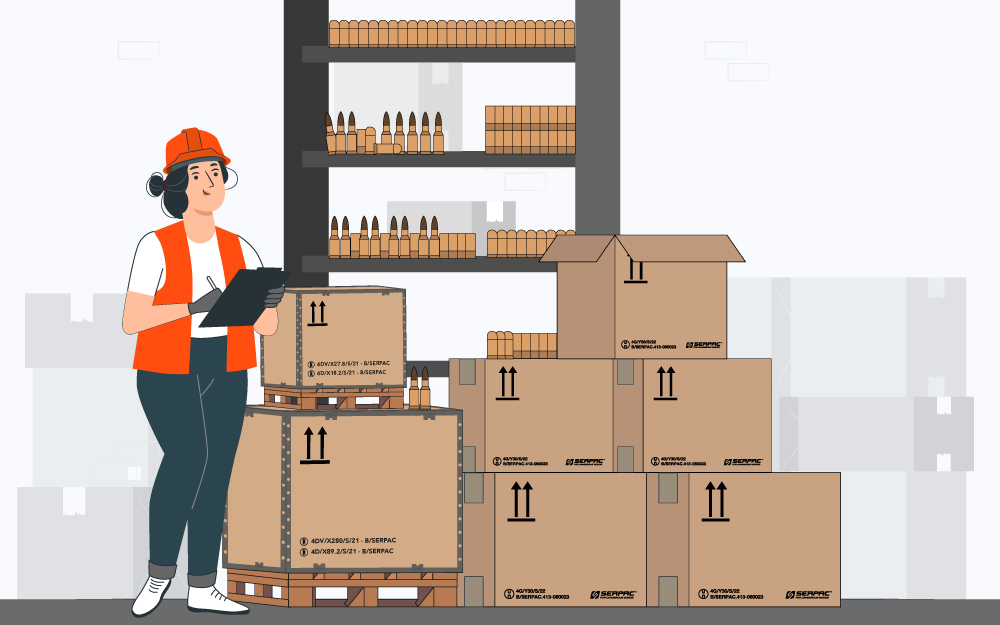Shipping cartridges and ammunition: a short guide.

The transport of dangerous goods is a complicated and risky business, that is why there are international norms that rule it in a very detailed way. These norms and regulations are developed according to the kind of goods transported and to the transport modality chosen: by road ADR, by railroad RID, by inner waterways ADN, by sea IMDG, and by air ICAO-TI / IATA.
To proceed with any shipment of dangerous goods, one must start by correctly classifying the goods. In the case of ammo, the main used classifications are the following ones:
- UN 0012 CARTRIDGES FOR WEAPONS, INERT PROJECTILE
- UN 0012 CARTRIDGES, SMALL ARMS
- UN 0014 CARTRIDGES FOR WEAPONS
- UN 0014 CARTRIDGES, SMALL ARMS, BLANK
- UN 0014 CARTRIDGES FOR TOOLS, BLANK
- UN 0055 CASES, CARTRIDGE, EMPTY, WITH PRIMER
Ammos’ producers must deal daily with these shipments and the related compliant and certified packages to use.
Ammos are mainly sent using UN-certified cardboard boxes (4G boxes) or UN-certified plywood cases (4D cases). Using one or the other is more of a personal choice, rather than enforcement by the law; both types of packaging are allowed according to regulations for the delivery of dangerous goods.
There is also another option that is basically never used for goods classified as explosive: shipping cartridges in Limited Quantities (Chapter 3.4 ADR, RID, ADN e IMDG). This is not allowed to transport by air these kinds of goods.
Let’s analyse first the opportunity to ship UN0012, UN0014, and UN0055 in Limited Quantities. Regulations, but the IATA one, allow you to do so, but is the Limited Quantity shipment of this kind of explosive goods as simple as it is for other dangerous goods?
Unluckily, Limited Quantities shipments are not as easy in this case, at least for what concerns the packaging performance. Normally a packaging designed for specific content and constructed according to 6.1.4as requested in Chapter 3.4) should be suitable for such a shipment, but these UN numbers. Even for Limited Quantity Shipments, a UN certification is anyway required for this kind of goods, as defined in Chapter 3.4.2 of ADR, according to Chapter 4.1.5.
Furthermore, through the special disposition no. 364 it is established that the object may be transported following Chapter 3.4 of the related manual only if the package, once ready for transportation, can pass the test of series 6(d) in Part I of Manual of tests and criteria, as stated from the competent authority.
Shipping UN0012, UN0014, and UN0055 in Limited Quantities is not that easy and, even if you want to pursue this method, you should anyway UN-certify a customized packaging.
UN-certifying customized packaging may seem hard but it is not. Some aspects should be thoroughly considered such as cartridges calibres, the inner packaging(s) to use, and the total number of inners that can be placed inside the UN-certified package, for instance in a 4G box. Many cartridges producers choose to certify a packaging on purpose for a specific kind of cartridge and inner packaging. It is important to focus on the fact that UN certification for 4Gs is a specific match between inner packaging(s), outer packaging, and all the other components that are a part of the package (filling and cushioning material, tape, etc.) If you want to use the same box to ship cartridges with different calibers or inner packaging(s) which are different than the ones the 4G was tested with, it will be necessary to extend the homologation.
Extending the homologation allows you to test a different content than the one already included in the test report of the packaging (a sort of the packaging “ID”) and therefore to ship other types of cartridges or cases inside a certain packaging. After proceeding with a feasibility study together with the certifying body, it is possible to test packaging for wider ranges of ammo and inners, identifying the most extreme conditions the packaging could have to withstand.
Another important aspect is the validity of the certification.
Some bodies certify packaging only for a few transport modalities: this represents a strong limitation in the use of the packaging.
Serpac always certifies packaging for all transport modalities possible and, upon yearly renewal, these certifications never expire, we test a packaging once with permanent validity. What matters is that there will be no changes compared to the tested prototype.
Is your UN certification expiring or do you want to produce a new 4G box or 4D case for the shipping of your cartridges?
Contact us to verify with us the best packaging solution.
- Ship safe -